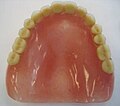Dentures: Difference between revisions
CSV import |
CSV import |
||
| Line 33: | Line 33: | ||
{{Medicine-stub}} | {{Medicine-stub}} | ||
<gallery> | |||
File:Mr_M's_Complete_Denture2.jpg|Complete denture example | |||
File:Occclusal_denture_example.jpg|Occlusal view of a denture | |||
File:Dentures_in_Marrakesh_Morocco.jpg|Dentures in Marrakesh, Morocco | |||
File:Carved_ivory_upper_and_lower_denture_Wellcome_L0003910.jpg|Carved ivory upper and lower denture | |||
File:Pierre_Fauchard_-_Le_Chirurgien_Dentiste_-_dentures.png|Historical dentures illustration | |||
</gallery> | |||
Latest revision as of 04:58, 18 February 2025
Dentures, also known as false teeth, are prosthetic devices constructed to replace missing teeth. They are supported by the surrounding soft and hard tissues of the oral cavity. Conventional dentures are removable; however, there are many different denture designs, some of which rely on bonding or clasping onto teeth or dental implants.
Types of Dentures[edit]
There are two main types of dentures: full and partial. Full dentures are used when all the teeth are missing, while partial dentures are used when some natural teeth remain.
Full Dentures[edit]
Full dentures can be further categorized into "conventional" or "immediate." A conventional type is made after the teeth have been removed and the gum tissue has begun to heal, while an immediate denture is made in advance and can be positioned as soon as the teeth are removed.
Partial Dentures[edit]
Partial dentures are often used when one or more natural teeth remain in the upper or lower jaw. They not only fill in the spaces created by missing teeth but also prevent other teeth from changing position.
Materials[edit]
Dentures are made from a variety of materials, including acrylic resin, nylon, or metal. The base of the denture is usually made of a rigid acrylic resin or a flexible (thermoplastic polyamide) material, while the teeth are typically made of acrylic resin or porcelain.
Fabrication[edit]
The process of fabricating a denture usually begins with a dental impression of the maxillary and mandibular ridges. From this, a model is made, which is used to create a denture that fits the mouth perfectly. Adjustments may be necessary as the mouth adapts to the dentures.
Care and Maintenance[edit]
Proper care is essential to extend the life of dentures and maintain oral health. This includes regular cleaning to remove food and plaque, as well as soaking them in a cleansing solution. It's also important to handle them carefully to avoid damage.
Complications[edit]
Wearing dentures can lead to several complications, including oral irritation, sores, and infections like cheilitis and stomatitis. Poorly fitting dentures can cause problems with eating and speech.
Alternatives[edit]
Alternatives to dentures include dental implants and bridges. Dental implants are surgical components that interface with the bone of the jaw or skull to support a dental prosthesis. Bridges are false teeth anchored in place by neighboring teeth.
Conclusion[edit]
Dentures are a valuable solution for individuals missing one or several teeth, significantly improving the quality of life. However, it's crucial to consult with a dental professional to choose the most appropriate type of denture and ensure proper fit and care.
-
Complete denture example
-
Occlusal view of a denture
-
Dentures in Marrakesh, Morocco
-
Carved ivory upper and lower denture
-
Historical dentures illustration





